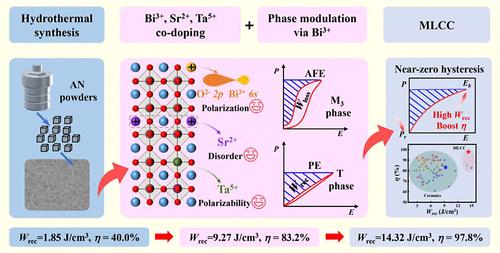相位调制导致agnbo3基陶瓷和多层电容器的超高储能性能
IF 8.2
2区 材料科学
Q1 MATERIALS SCIENCE, MULTIDISCIPLINARY
引用次数: 0
摘要
反铁电(AFE)陶瓷是先进大功率器件中极具竞争力的储能材料。然而,较差的可采能量密度和效率严重阻碍了其应用。在这里,Bi3+-, Sr2+-和Ta5+-共掺杂agnbo3基陶瓷获得了卓越的储能性能。具体而言,通过Bi3+的有效相位调制,准电T相在室温下稳定,在(Ag0.71Bi0.07Sr0.04)(Nb0.85Ta0.15)O3陶瓷中,可回收储能密度为9.27 J/cm3,效率为83.2%。相应的多层陶瓷电容器(MLCC)进一步将可回收储能密度提高到14.32 J/cm3,效率提高到97.8%,这几乎是我们所知的ann基陶瓷和MLCC中综合储能性能最好的。所提出的策略一般适用于设计高性能储能器件和AFE介电材料的其他功能。本文章由计算机程序翻译,如有差异,请以英文原文为准。

Phase Modulation Leads to Ultrahigh Energy Storage Performance in AgNbO3-Based Ceramics and Multilayer Capacitors
Antiferroelectric (AFE) ceramics are competitive energy storage candidates for advanced high-power devices. However, the poor recoverable energy density and efficiency are challenging and severely hinder their applications. Here, superior energy storage performance is obtained in Bi3+-, Sr2+-, and Ta5+-codoped AgNbO3-based ceramics. Specifically, with the effective phase modulation via Bi3+, the paraelectric T phase stabilizes at room temperature and facilitates a recoverable energy storage density of 9.27 J/cm3 and an efficiency of 83.2% in (Ag0.71Bi0.07Sr0.04)(Nb0.85Ta0.15)O3 ceramics. The corresponding multilayer ceramic capacitor (MLCC) further promotes the recoverable energy storage density to 14.32 J/cm3 and efficiency to 97.8%, which is almost the best comprehensive energy storage performance among AN-based ceramics and MLCCs to the best of our knowledge. The proposed strategy is generally applicable to design high-performance energy storage devices and other functionalities of AFE dielectric materials.
求助全文
通过发布文献求助,成功后即可免费获取论文全文。
去求助
来源期刊

ACS Applied Materials & Interfaces
工程技术-材料科学:综合
CiteScore
16.00
自引率
6.30%
发文量
4978
审稿时长
1.8 months
期刊介绍:
ACS Applied Materials & Interfaces is a leading interdisciplinary journal that brings together chemists, engineers, physicists, and biologists to explore the development and utilization of newly-discovered materials and interfacial processes for specific applications. Our journal has experienced remarkable growth since its establishment in 2009, both in terms of the number of articles published and the impact of the research showcased. We are proud to foster a truly global community, with the majority of published articles originating from outside the United States, reflecting the rapid growth of applied research worldwide.
 求助内容:
求助内容: 应助结果提醒方式:
应助结果提醒方式:


